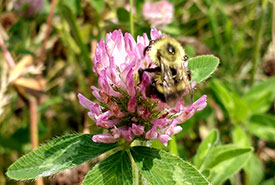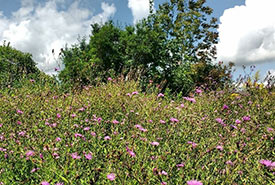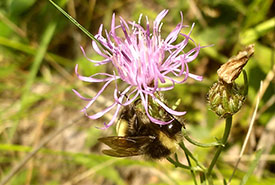Buzzing down the house: Determining the habitat for declining bumble bees

Bumble bee foraging on red clover (Photo by Amanda Liczner)
Bumble bees are important pollinators of crop plants and wild plants. Unfortunately, bumble bee species are declining globally. These declines are likely due to several factors, including climate change, a pathogen spread from imported bees, pesticide use, competition from invasive species and habitat loss.
To help reverse bumble bee declines, we must address these threats. Focusing on habitat loss is important, because a species’ habitat contains all the resources needed for survival. Having a lot of suitable habitat can also help species survive other threats.
There is a problem, though. We currently do not know what makes up the habitat for bumble bees. If we don’t know what we are looking for, how can we conserve it?
Generally, bumble bees need food, a place to nest and somewhere to survive the winter. Food for bumble bees is pollen and nectar collected from flowers, but we know little about nesting or overwintering resources. Some bumble bees will nest underground, while others may nest above ground but under a plant. Some bumble bees may even use animal burrows for nests. Winter is important too — bumble bees are thought to overwinter underground or in decaying logs.

One of the survey sites (Photo by Amanda Liczner)
I set out with a research team in the spring and summer of 2017 to survey locations where there was a recent sighting of two different bumble bee species that are in decline: the yellow-banded bumble bee and the American bumble bee. Together, we surveyed 25 sites across southern Ontario, including the Nature Conservancy of Canada’s (NCC’s) Backus Woods and Lake Erie Farms properties. We measured variables thought to be important in determining bumble bee habitat. These include the amount of flowering plant species, number of animal burrows, presence of decaying logs and vegetation cover, to name a few.

Yellow-banded bumble bee (Photo by Amanda Liczner)
I am still working on analyzing the data we collected this year. Our early results suggest that the yellow-banded bumble bee and the American bumble bee have very different habitat preferences. The yellow-banded bumble bee prefers wet and forested sites near open water. Meanwhile, the American bumble bee prefers open sites like grasslands, urban green spaces and agricultural areas. This means that it is important to provide the preferred habitat for the conservation of declining species.
I hope that the results of my work will help inform bumble bee conservation. This includes identifying areas that should be protected and how organizations like NCC can expand bumble bee habitat to help increase bumble bee populations.


